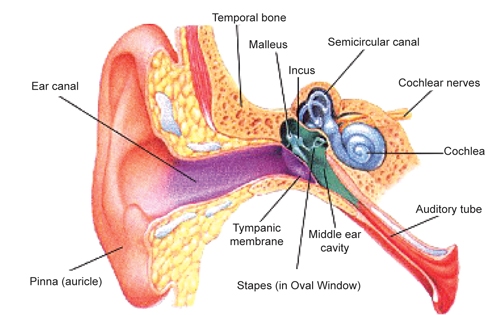How the Ear Works
There are three general areas that make up the structure of the ear. Each area works together converting sound waves into electrical signals. These signals are then translated into sound by the brain. Learn more about how the ear works below.
The Outer Ear Structure
The auricle (pinna) is the visible portion of the outer ear. It collects sound waves and channels them into the external auditory meatus (ear canal) where the sound is amplified. The sound waves then travel toward a flexible, oval membrane at the end of the external auditory meatus called the tympanic membrane (eardrum). The tympanic membrane begins to vibrate.
The Middle Ear Structure
The vibrations from the eardrum set the ossicles into motion. The ossicles are three tiny bones (smallest in the human body): malleus (hammer), incus (anvil), and stapes (stirrup), which further amplify the sound. The stapes attaches to the oval window that connects the middle ear to the inner ear. The Eustachian tube, which opens into the middle ear, is responsible for equalizing the pressure between the air outside the ear to that within the middle ear.
The Inner Ear Structure
The sound waves enter the inner ear and then into the cochlea, a snail-shaped organ. The cochlea is filled with a fluid that moves in response to the vibrations from the oval window. As the fluid moves, 25,000 nerve endings are set into motion. These nerve endings transform the vibrations into electrical impulses that then travel along the VIII cranial nerve (auditory nerve) to the brain. The brain then interprets these signals and this is how we hear. The inner ear also contains the vestibular organ that is responsible for balance.

